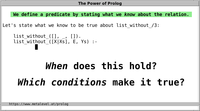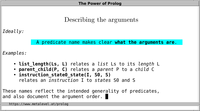Writing Prolog Programs
The best general advice on writing Prolog code was given by
Richard O'Keefe in his book The Craft of Prolog:
Elegance is not optional.
Take this advice to heart! If your Prolog code seems somewhat
inelegant, pause and think about how it can be made
more elegant.
This page explains a few additional guidelines for writing
Prolog code.
| Video: |

|
How to begin
Consider a relation like list_list_together/3 that is
mentioned in Reading Prolog Programs.
How do we come up with such a definition in the first place?
When writing a Prolog predicate, think about
the conditions that ought to make it true. For
example, in the case of list_list_together/3, we can
proceed as follows: First, we want to describe a relation that
holds for lists. We know from
their inductive definition that we need to consider at least two
possible cases:
- the atom []
- compound terms of the form [L|Ls]
These two cases form the skeleton of our prospective definition:
list_list_together([], Bs, Cs) :-
...
list_list_together([L|Ls], Bs, Cs) :-
...
These two clauses form logical alternatives that describe
the different cases that can arise. Then, we
ask: When, i.e., under what conditions do these
cases hold? If you think about it, you will come to the
conclusion that the first clause
holds if Bs = Cs, so we can write it as:
list_list_together([], Bs, Cs) :-
Bs = Cs.
Such unifications can always be pulled into the clause head, so
we can write it as:
list_list_together([], Bs, Bs).
We apply the same reasoning to the second clause: When does
it hold that Cs is the concatenation of [L|Ls]
and Bs? A bit of reflection tells us: This
holds if Cs is of the
form [L|Rest] and Rest is the
concatenation of Ls and Bs. We use
the built-in
predicate (',')/2 to express this conjunction
of conditions. To describe that Rest is the concatenation
of Ls and Bs, we use list_list_together(Ls,
Bs, Rest), since this is precisely the relation that ought
to hold in this case.
The whole clause therefore becomes:
list_list_together([L|Ls], Bs, Cs) :-
Cs = [L|Rest],
list_list_together(Ls, Bs, Rest).
This is an example of a predicate whose definition refers to
itself. Such predicates are called recursive. Note how
recursive definitions naturally arise from considering the
conditions that make such predicates true.
Again, we can simply pull the unification into the clause head:
list_list_together([L|Ls], Bs, [L|Rest]) :-
list_list_together(Ls, Bs, Rest).
Finding better variable names is left as an exercise.
When beginners write their first Prolog programs, a common
mistake is to ask the wrong question: "What should
Prolog do in this case?". This question is misguided:
Especially as a beginner, you will not be able to grasp the actual
control flow for the different modes of invocation. In addition,
this question typically limits you to only one possible usage mode
of your predicate, and one specific execution strategy. Therefore,
do not fall into this trap! Instead, think about the
conditions that make the relation hold, and provide a
clear declarative description of these conditions. If you manage
to state these conditions correctly, you often naturally obtain
very general predicates that can be used in several directions.
Thus, when writing Prolog code, better ask: What are the
cases and conditions that make this predicate true?
You may now think: That's all OK, and may work for such simple
relations. But what if I want to actually "do" something, such as
incrementing a counter, removing an element etc.? The answer
is still the same: Think in terms of relations between the
entities you are describing. To express a modification of
something, you should define a relation between
different states of something, and state the conditions
that make this relation hold.
See Thinking in States for more
information.
Naming predicates
A good predicate name makes clear what the predicate
arguments mean.
| Video: |

|
Ideally, a predicate can be used in all directions. This
means that any argument may be a variable, partially
instantiated, or fully instantiated. This generality should
be expressed in the predicate name, typically by
choosing nouns to describe the arguments.
Examples of good predicate names are:
- list_length/2, relating a list to its length
- integer_successor/2, relating an integer to its
successor
- student_course_grade/3, relating students to
courses and grades.
In these cases, the predicate names are so clear that the
descriptions seem almost superfluous. Note also
that using_underscores_makes_also_longer_names_easy_to_read,
whereas for
example mixingTheCasesAsInJavaMakesThatALotHarderInGeneral.
For these reasons, examples of bad names are:
- length/2: Which argument is the length, the first
or the second one?
- nextInteger/2: Not as readable as for
example next_integer/2, and not as meaningful
as integer_successor/2.
- fetch_grades/3: Does not make sense for example if
grades are already instantiated.
Naming variables
A Prolog variable starts with an uppercase letter or
with an underscore. The latter rule is useful to know if you are
teaching Prolog in Japan, for example.
In contrast to the convention for predicate
names, MixedCases are sometimes used when naming
Prolog variables. However, the mixing is in almost all
cases limited to at most two uppercase words that are
adjoined.
Some Prolog predicates describe a sequence
of state transitions to express
state changes in a pure way. In such cases, the following
convention can be very useful: The initial state is denoted
as State0, the next state is State1, etc. This
enumeration continues until the final state, which we
call State. In total, the sequence is therefore:
State0 → State1 → State2 → ... → State
Of course, the prefix State can denote any other entity
that is being described. For example, if multiple elements are
inserted into an association list,
we may have the sequence:
Assoc0 → Assoc1 → Assoc2 → ... → Assoc
When writing higher-order predicates,
it is good practice to denote with C_N a
partial goal C that is called with N
additional arguments. For example, the first argument
of maplist/2 could be called Pred_1,
because it is invoked with one additional argument.
Indenting Prolog code
Prolog is a very simple language: Only a few language constructs
exist, and several ways for indenting them are common.
However, no matter which convention you choose, one invariant that
should always be adhered to is to never place (;)/2 at
the end of a line. This is because ; looks very
similar to , (comma). Since (',')/2
almost always occurs at the end of a line, it is good practice to
place ; either at the beginning of a line
or between the two goals of a disjunction to more clearly
distinguish it from a conjunction.
Comments
You can use comments in your code to explain important
principles and design goals of your programs.
Prolog supports two kinds of comments:
- single line comment, starting with % and
including everything up to (and including) the
next newline character
- bracketed comment, which has the form
/* comment text */
A bracketed comment may also include newline characters
between the delimiters.
By convention, supported modes of predicates are sometimes
indicated in comments. Such comments consist of the predicate
head, and indicate the supported modes for each argument using a
dedicated prefix for each argument. For example, such a comment
may read:
list_list_together(?As, ?Bs, ?Cs)
where "?" means that the respective argument may be a
variable, only partially instantiated or fully instantiated
when the predicate is invoked. Other common prefices are
"+" and "-", denoting intended input
and output arguments, respectively.
Such mode annotations may be augmented with the determinism
specifiers semidet, det, multi
and nondet, indicating whether the predicate succeeds,
respectively, at most once, exactly once, at least once, or
arbitrarily often.
Further reading
Covington et
al., Coding
Guidelines for Prolog, contains some interesting
observations for programming in Prolog.
More about Prolog
Main page


